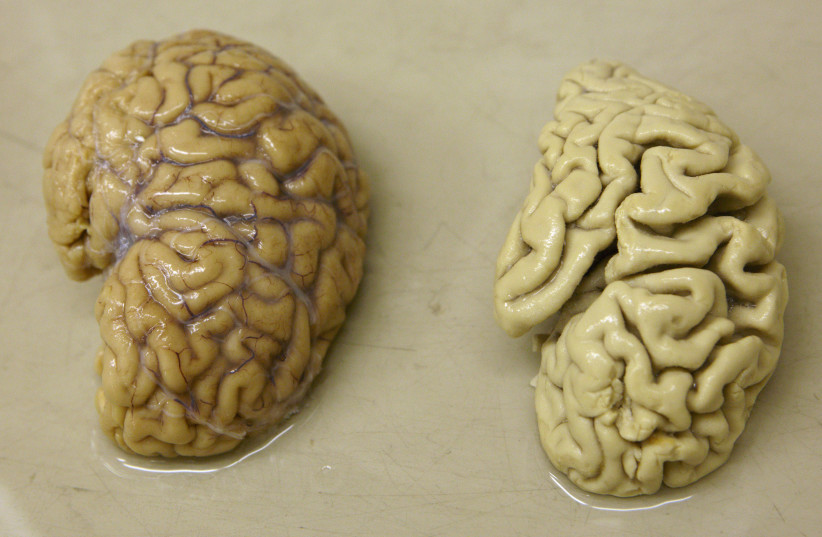Elite soccer players are 1.5 times more likely to develop a neurodegenerative disease like Alzheimer's disease than the general public, according to a new study.
The peer-reviewed study, which was published in The Lancet on Thursday, aimed to determine the risk of neurodegenerative disease among male players in the top Swedish soccer division Allsvenskan compared to the general population.
Among this demographic, 9%, or 537 out of 6,007, were diagnosed with neurodegenerative disease, compared to 6%, or 3,485 out of 56,168 of the general population.
The researchers who conducted the study identified all male soccer players - both amateur and professional - who had played at least one game in Allsvenskan between August 1, 1924, and December 31, 2019, excluding players whose personal identity numbers could not be retrieved or identified in the Total Population Register and players who were not born in Sweden and who had immigrated to Sweden after they were 15 years old.
The players were then matched with up to ten controls from the general population based on factors such as age, sex and region of residence. The researchers then used national registers to compare the risk of neurodegenerative disease among soccer players compared to the control.


Brain injuries in contact sports
The study comes amid growing concerns about brain trauma sustained by players of soccer and other contact sports, such as football and rugby.
A previous study in Scotland suggested that soccer players are 3.5 times more likely to develop neurodegenerative disease than the general population. After the study was published, some soccer associations implemented new measures aimed at reducing head injuries among youth players and in training.
Risk of neurodegenerative disease by position
“Importantly, our findings suggest that goalkeepers don’t have the same increased risk of neurodegenerative disease as outfield players.”
Asst. Prof. Peter Ueda, Karolinska Institutet
The study found that outfield players were 1.5 times more likely to develop neurodegenerative disease compared to controls but goalkeepers were not significantly more likely to develop neurodegenerative disease than controls.
In a direct comparison, outfield players were 1.4 times more likely to develop neurodegenerative disease than goalkeepers.
“Importantly, our findings suggest that goalkeepers don’t have the same increased risk of neurodegenerative disease as outfield players,” said Asst. Prof. Peter Ueda of Sweden's Karolinska Institutet. “Goalkeepers rarely head the ball, unlike outfield players, but are exposed to similar environments and lifestyles during their football careers and perhaps also after retirement.
“It has been hypothesized that repetitive mild head trauma sustained through heading the ball is the reason football players are at increased risk, and it could be that the difference in neurodegenerative disease risk between these two types of players supports this theory.”
The researchers noted that though 9% of soccer players and 6% of controls were diagnosed with neurodegenerative disease during their study, most people who were included in the study were still alive when the researchers finished collecting the data, so the risk of developing neurodegenerative disease is probably higher for both groups.
The study found that soccer players were 1.6 times more likely to develop Alzheimer's disease and other dementias compared to controls, but that there was no significant increase in the risk for motor neuron disease, including Amyotrophic lateral sclerosis (ALS). Furthermore, soccer players were actually less likely to develop Parkinson's disease. Additionally, overall mortality was slightly lower among soccer players compared to controls, at 40% and 42%, respectively.
“The lower overall mortality we observed among footballers indicates that their overall health was better than the general population, likely because of maintaining good physical fitness from frequently playing football,” said Björn Pasternak, a senior researcher at Karolinska Institutet.
“Physical activity is associated with a lower risk of dementia, so it could be hypothesized that the potential risks from head impacts are being somewhat offset by having good physical fitness. Good physical fitness may also be the reason behind the lower risk of Parkinson’s disease.”
Limitations of the study
The study noted that since neurodegenerative disease usually occurs later in life, most players included in the study who were old enough to have developed such a disease played soccer during the mid-20th century. Since then, the sport has changed in ways that could impact the risk of neurodegenerative disease, such as switching from leather to synthetic balls, which do not soak up water and become heavier, improved training and a safer playstyle.
However, the risk of neurodegenerative disease could be higher among players who train and play more intensely from a young age.
“The overall evidence supports the hypothesis that former elite football players are at increased risk of neurodegenerative disease, especially Alzheimer's disease and other dementias, and that the risk increase is limited to outfield players. However, the magnitude of the association might differ across populations of elite football players, including female players, and whether the findings are generalisable to contemporary football players is uncertain,” the study found.
